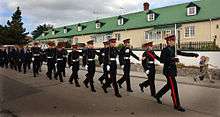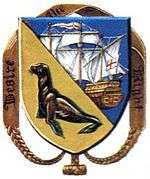Falkland Islands Defence Force
| Falkland Islands Defence Force | |
|---|---|
|
Badge of the Falkland Islands Defence Force | |
| Active |
1892–1982 1983 – present |
| Country | Falkland Islands, United Kingdom |
| Allegiance | Elizabeth II (United Kingdom) |
| Type | Military reserve force |
| Role | Light Role with additional roles |
| Size |
One Company 2 Permanent Staff Personnel ~100 Primary Reserve Personnel ~100 Secondary Reserve Personnel |
| Garrison/HQ | Port Stanley |
| Nickname(s) | Falklands Army |
| Battle honours | Falklands War |
| Commanders | |
| Commanding Officer | Major Biggs |
The Falkland Islands Defence Force (FIDF) is the locally maintained volunteer defence unit in the Falkland Islands, a British Overseas Territory. The FIDF works alongside the military units supplied by the United Kingdom to ensure the security of the islands.
History
The first volunteer unit in the Islands was formed in 1854 during the Crimean War to guard against possible aggression by the Russian Empire. Not given an official title, this unit was sometimes known as the Stanley Volunteers. However, the modern unit traces its direct lineage back to 1892. The previous year, a steamer owned by one of the groups involved in the Chilean Civil War docked at Stanley. Although ostensibly there to carry out repairs to its engines, the presence onboard of 200 armed soldiers was considered a security threat. So, the Governor, Sir Roger Goldsworthy, ordered that an armed volunteer force be formed. The first draft of men of the new Falkland Islands Volunteers were sworn in at a ceremony at Government House in June 1892.
During the First World War, members of the Volunteers were mobilised to man military outposts around the Islands, while 36 Falklanders enlisted in the armed forces. At the end of the war, the Falkland Islands Volunteers was renamed as the Falkland Islands Defence Force. The FIDF was mobilised again during the Second World War, manning defensive outposts around the Islands. At this time, a mounted rifles unit was raised.

In 1939, a group called the "Tabaris Highlanders" arrived on the islands for a brief two months. They were from the Anglo-Argentine community, and were supposed to defend the islands from a German attack during World War II. 33 men arrived in the Falklands on 27 September 1939; six were rejected on medical and other grounds and returned to Buenos Aires almost immediately. The 'commanding officer', a Major Morrough, was one of those rejected. The remainder were enrolled in the FIDF, with Ronald Campbell made Sergeant as their group commander and Thomas Dawson Sanderson as Corporal. They left the Islands on 8 December 1939, once the immediate danger of attack from German raiders was judged to have receded. During this time the Highlanders dug out gun pits, embankments, and protection of every sort from a possible German naval attack. While they were only in the Islands for just over two months, 22 of them applied from Stanley to join the British Forces. Many of this group were rugby players, including Cpl Thomas Dawson Sanderson, who was president of a rugby club.[1]
After the end of the war, the presence of Royal Marines as part of the Islands' defence led to the FIDF adopting RM dress and drill styles. On 28 September 1966,[2] 19 members of an Argentine extremist group staged a symbolic invasion of the Islands by landing a DC-4 on Stanley Racecourse, in one of the first significant hijacking incidents; the extremist group called this action Operation Condor. There, they took four islanders hostage. The FIDF, alongside the Royal Marines, contained the situation and the group surrendered without casualties. Following this, the FIDF was on heightened alert until February 1967.
Falklands War
On 1 April 1982, alongside the Royal Marines party, the FIDF was mobilised to defend the Islands from the Argentine invasion. Of its approx 120 men only 23 turned out.[3] The following day, Sir Rex Hunt ordered them to surrender. The Argentines confiscated all of the FIDF's equipment and declared them to be an illegal organisation. For the duration of the war, some members of the FIDF were kept under house arrest at Fox Bay until the Argentine surrender. The FIDF was reformed in 1983.
Terry Peck, a former member of the Defence Force, spied on Argentine forces in Stanley, then escaped to become a scout for the 3rd Battalion, Parachute Regiment, with which he fought at the Battle of Mount Longdon.
Today
Personnel

Today the Falkland Islands Defence Force meet once a week for training, with various extended training weekends throughout the year. Soldiers of the Falkland Islands Defence Force conduct training patrols with soldiers from the British Garrison on the islands as well as acting as "enemy" forces against British soldiers in training exercises.
FIDF soldiers also provide search and rescue and mountain rescue services across the islands. They have been trained by the Royal Navy to operate Oerlikon 20mm cannon and conduct boarding operations of vessels to fulfill a fisheries protection role for the Falkland Islands Government.
Equipment
- Land Rovers
- Quad bikes
- Rigid Raider boats
- Steyr AUG assault rifle
- Steyr AUG HBAR (Heavy-Barreled Automatic Rifle) light support weapon
- Browning Hi-Power pistol
- L7 general purpose machine gun
- Manroy M2HB .50 inch machine gun[4]
- Sniper rifle
- Grenade launcher
Funding
The Falkland Islands Defence Force today is funded entirely by the Falkland Islands government and has an annual budget of £400,000.[5]
Organisation

The FIDF is organised as a light infantry company with additional roles. It is manned entirely by the local population, following British Army doctrine, training and operations. In an agreement with the British Ministry of Defence, a Royal Marines Warrant Officer Class 2 is seconded to the Force as a Permanent Staff Instructor. Two permanent soldiers from the islands are employed as the Force's Commanding Officer, ranked as a Major, and as the senior non-commissioned officer, ranked as a Sergeant Major.
Alliances
 United Kingdom - The Yorkshire Regiment (14th/15th, 19th and 33rd/76th Foot)
United Kingdom - The Yorkshire Regiment (14th/15th, 19th and 33rd/76th Foot) United Kingdom - Royal Marines
United Kingdom - Royal Marines
See also
- Military of the Falkland Islands
- Bermuda Regiment
- Royal Gibraltar Regiment
- Royal Montserrat Defence Force
- Royal Hong Kong Regiment (defunct)
References
- ↑ Dictionary of Falklands Biography 1592 - 1981; TABARIS HIGHLANDERS (1939), retrieved 10 September 2009
- ↑ ASN Aircraft accident Douglas DC-4 LV-AGG Port Stanley
- ↑ M.Hastings, S.Jenkins "The Battle for the Falklands", W.W.Norton & Co., London & New York, 1983, Chapter 5, page 72
- ↑ Defense & Security Intelligence & Analysis - Special Forces (Land) (Falkland Islands), Amphibious and special forces
- ↑ The Times Article, March 6th 2010, retrieved 23 July 2011
External links
| Wikimedia Commons has media related to Falkland Islands Defence Force. |
- Falkland Islands Information Portal. "Falkland Islands Defence Force: 150 years of Voluntary Service". Retrieved 19 June 2006.
- BBC News (2007-06-11). "Audio slideshow: Island defenders". Retrieved 11 June 2007.
